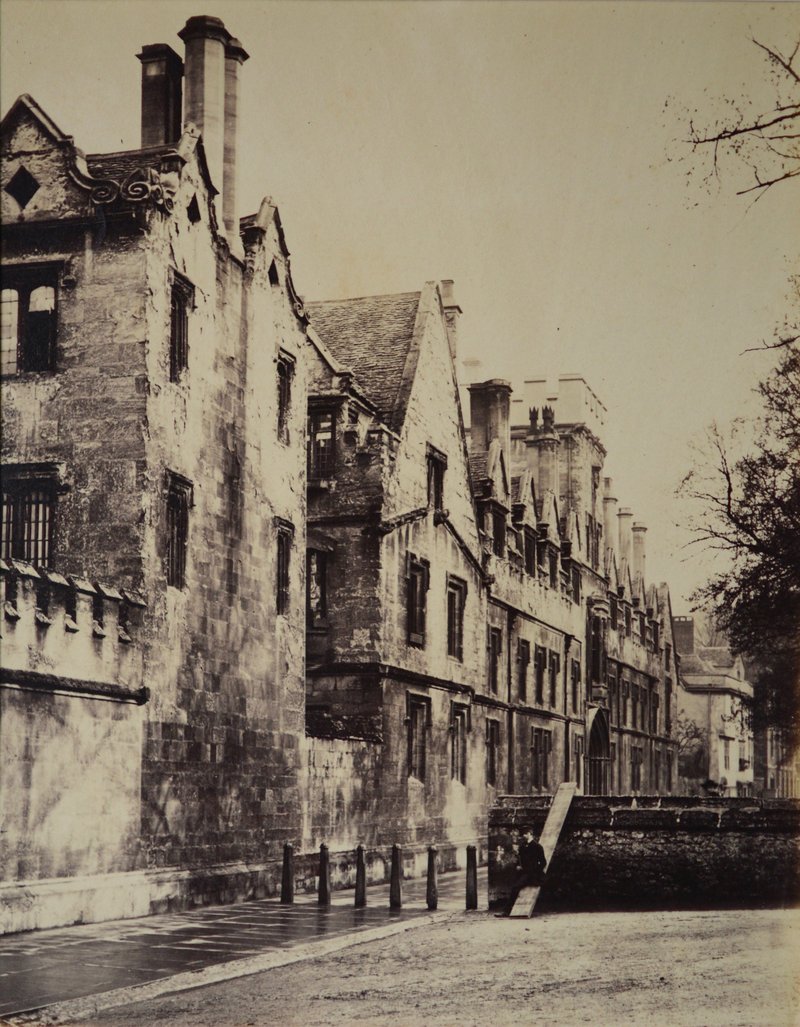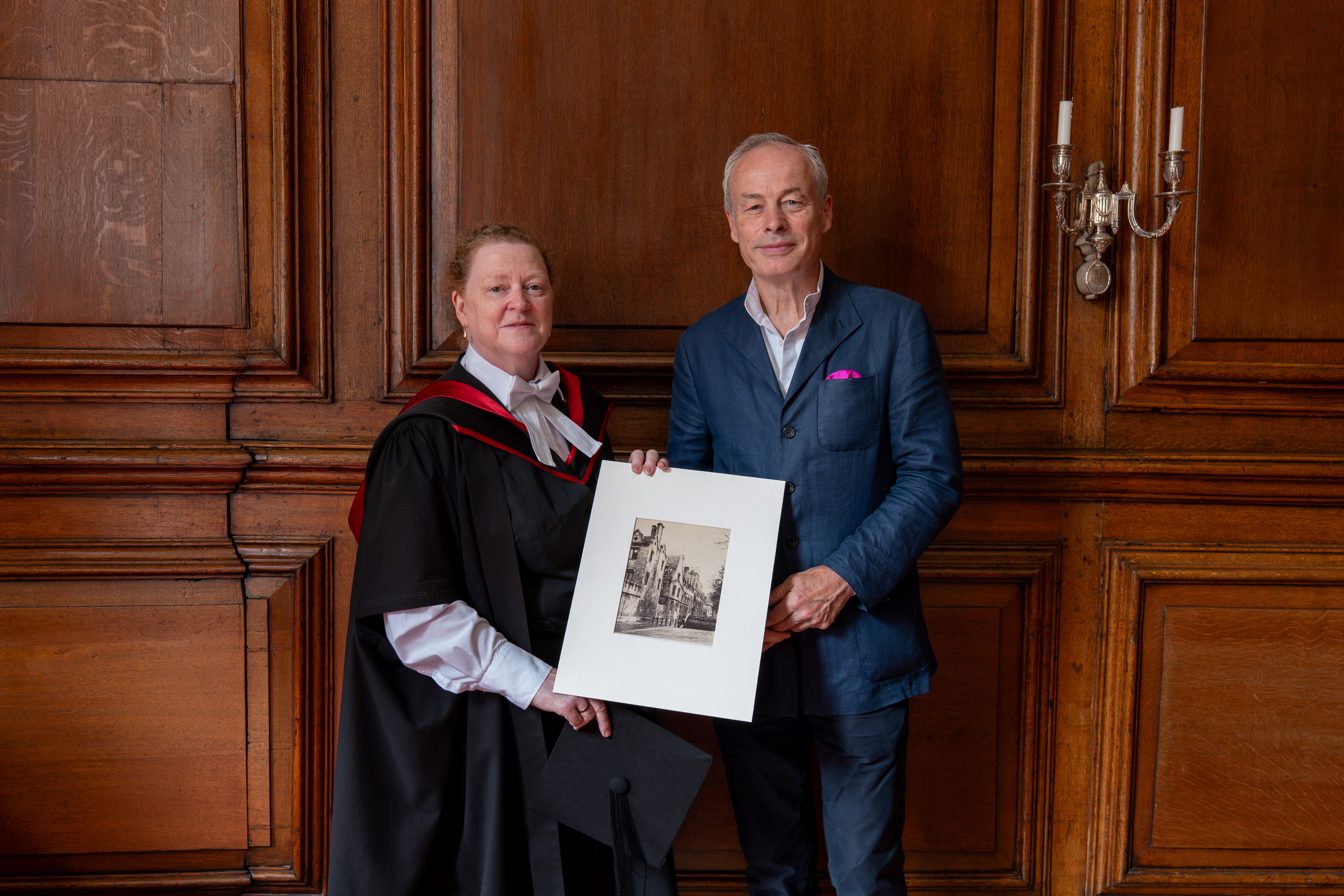Alumni donate historic photograph of St John's
On 25 June 2025, Stephen Barber and Mark Bedingham donated an historic photograph (below) to St John’s in commemoration of the fiftieth anniversary of their matriculation and first encounter at the College.
The donated photograph depicts the west range of Front Quad and the College’s embattled gate tower, as well as Cook’s Buildings in North Quad, as seen from St Giles looking southward. Although it is impossible to definitively attribute the photograph, all the available evidence suggests that it was taken by the pre-eminent photographer, Roger Fenton (1819–1869), during the brief period that he spent working in Oxford in the late 1850s.
" I first encountered this unique - as far as we know - print of the College six years ago. I hesitated to acquire it until this year. A few weeks ago, I was having dinner with Mark Bedingham, my St John’s contemporary, and it suddenly occurred to me that he and I should jointly acquire the work and present it to the College, to mark the 50th anniversary of our friendship, born and forged at St John’s and as strong as ever to this day. We can think of no better or more deserving home. " Steven Barber

Dr Georgy Kantor, Keeper of the Pictures, welcomed the donation:
" The College has always tried to collect works of art documenting its history and buildings. Nineteenth-century views of St John’s in our collection include works by William Turner of Oxford, George Pyne and Joseph Pennell, among others. We were late, however, to develop an interest in the art of photography for our collection, and the earliest artist’s photographs of the College were commissioned within living memory. This incredibly generous gift of Roger Fenton’s image of the St Giles’ front of the College, made just a few years after the foundation of the Royal Photographic Society, takes us more than a century earlier than that, to the first pioneering efforts of British photography. These days, St John’s provides one of the venues for the biennial Photo Oxford festival and for the Royal Photographic Society Documentary Photographer of the Year exhibitions, and it is exciting to add a deeper historical dimension to our engagement with modern photography. We are most deeply grateful to Stephen Barber and Mark Bedingham for their donation. " Georgy Kantor
 Stephen Barber presents the photograph to Professor Lady Sue Black, President of St John's College
Stephen Barber presents the photograph to Professor Lady Sue Black, President of St John's College
About Fenton
Roger Fenton was born at Crimble Hall, Lancashire, in March 1819. He graduated with a BA from University College, London in 1840, before spending the next decade studying the law, eventually being called to the bar in May 1851. A substantial legacy from his grandfather, Joseph Fenton, allowed Roger to study sporadically as an artist in Paris and London during his legal training. During this early period, three of Fenton’s paintings were exhibited at the Royal Academy.
Fenton was an early adopter of photography, travelling to Russia in 1852, where he produced a series of career-making photographs of monasteries and churches in Moscow and St Petersburg. On returning to England, Fenton helped found the Photographic Society of London (later the Royal Photographic Society, 1894): the leading group promoting the artistic status of the new medium in Britain. As Honorary Secretary, Fenton escorted Queen Victoria and Prince Albert around the gallery during the Society’s inaugural exhibition in January 1854.
Royal favour secured Fenton’s safe passage to Crimea in March 1855, where he became the first Briton to act as an official war photographer. Despite only spending four testing months in Crimea, Fenton remarkably produced 360 photographs: mainly heroic portraits of soldiers and expansive battlefield scenes. It is for these photographs, most notably his image of the site of the Charge of the Light Brigade – made famous by Lord Tennyson’s poem of the same name – that Fenton won widespread acclaim.
After the Crimean War, Fenton resumed his role as official photographer to the British Museum, and re-devoted himself to the affairs of the Photographic Society. At the Society’s seventh annual exhibition in 1860, he exhibited several striking views of Oxford. These included photographs of Wadham College, the New College cloisters, the Lily House and the entrance at the Botanic Gardens, as well as Magdalen College tower.
Although they do not appear in the official 1860 exhibition catalogue (available here), other contemporary Oxford views attributed to Fenton appear in the V&A’s Royal Photographic Society Collection. These include several photographs of University College, Merton College, and the University’s Museum of Natural History, then still under construction.
Fenton also contributed to a series of stereoscopic images of Oxford, produced by the local firm Spiers and Son. (Interestingly, the proprietor, Richard Spiers, lived with his family at 14 St Giles: one of the College’s properties.) Fenton had been a very early experimenter with stereoscopy – an innovative format which recreated the illusion of depth by combining two flat perspectives taken from two slightly different points of view – taking several stereos of the rooms and exhibits at the British Museum. In June 1860, an advert appeared in the Oxford Chronicle and Reading Gazette for ‘OXFORD IN THE STEREOSCOPE; a series of Views photographed by Delamotte, Cundall, Roger Fenton, Howlett, and other celebrated Artists’. Although it is difficult to establish which of the eighty views featured in this series were taken by Fenton and which by the ‘other celebrated Artists’ commissioned by Spiers, two are confirmed by Fenton’s distinctive blind stamp.
There is clear evidence, then, of Fenton visiting Oxford between returning from the Crimean War in 1855 and the summer of 1860 when his photographs of the University and the city were exhibited and sold. It is almost certain that the recently donated photograph of St John’s was taken by Fenton during this period.
Inexplicably, given that he was the preeminent photographer of the period, Fenton gave up photography entirely in 1862. He returned to his career at the bar, continuing to practice until his death in August 1869.
" Many practitioners believed that photography could teach the mind to see, Fenton also uniquely showed how photography could teach us to see the mind. " Robert Hershowitz, email to Stephen Barber, 24 June 2025